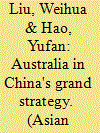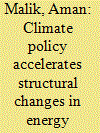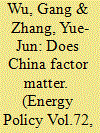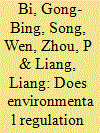|
|
|
Sort Order |
|
|
|
Items / Page
|
|
|
|
|
|
|
| Srl | Item |
| 1 |
ID:
132660


|
|
Analysis of monthly household energy consumption among single-f
/ Valenzuela, Carlos; Valencia, Alelhie; White, Steve; Jordan, Jeffrey A, Cano, Stephanie, Keating, Jerome, Nagorski, John, Potter, L.B
|

|
|
|
|
| Publication |
2014.
|
| Summary/Abstract |
Demographic, socioeconomic, and housing characteristics influence variation in household energy consumption. By combining household-level utility, public, and proprietary data, we examine predictors of household energy consumption in a Texas urban area. Using quantile regression, this analysis assesses the relationship between energy consumption and predictors at the middle and both ends of the distribution (10th and 90th percentiles). Results indicate potential opportunities to lower consumption among the highest energy-consuming households including those with pools, with non-central cooling, with people working from home, those built on pier/post foundation, and those that are renter-occupied. These findings suggest significant opportunities to reduce consumption and demand as in the study area, almost 10% of housing units are renter-occupied, 18% percent are without central cooling, and 7% have pools. Capturing a significant portion of these homes for retrofit conservation efforts through marketing has potential to produce substantial results. Producing a better understanding of determinants of household energy consumption using the methods presented has potential to assist development and implementation of strategies to reduce consumption and increase efficiency.
|
|
|
|
|
|
|
|
|
|
|
|
|
|
|
|
| 2 |
ID:
128035


|
|
|
|
|
| Publication |
2014.
|
| Summary/Abstract |
Gujarat, a large industrialized state in India, consumed 67 TWh of electricity in 2009-10, besides experiencing a 4.5% demand-supply short-fall. Residential sector accounted for 15% of the total electricity consumption. We conducted load research survey across 21 cities and towns of the state to estimate residential electricity load curves, share of appliances by type and usage patterns for all types of household appliances at utility, geographic, appliance, income and end-use levels. The results indicate that a large scope exists for penetration of energy efficient devices in residential sector. Marginal Abatement Cost (MAC) curves for electricity and CO2 were generated to analyze relative attractiveness of energy efficient appliance options. Results indicate that up to 7.9 TWh of electricity can be saved per year with 6.7 Mt-CO2 emissions mitigation at negative or very low CO2 prices of US$ 10/t-CO2. Despite such options existing, their penetration is not realized due to myriad barriers such as financial, institutional or awareness and therefore cannot be taken as baseline options for CO2 emission mitigation regimes.
|
|
|
|
|
|
|
|
|
|
|
|
|
|
|
|
| 3 |
ID:
130176


|
|
|
|
|
| Publication |
2014.
|
| Summary/Abstract |
This paper examines China's strategic interests in Australia. From the security per- spective, Beijing hopes that Australia will be a constructive factor for its peaceful rise. On the economic side, Beijing hopes that the bilateral relationship will ensure sufficient and sustainable resources and energy supplies from Australia for China's domestic needs
|
|
|
|
|
|
|
|
|
|
|
|
|
|
|
|
| 4 |
ID:
132602


|
|
|
|
|
| Publication |
2014.
|
| Summary/Abstract |
In order to find efficient trade measures to reduce China×s energy consumption and to provide theoretical support for the climate talks between China and America, we investigate the impact of Sino-USA trade on energy consumption from the perspective of embodied energy. An Environmental Input-Output Life Cycle Assessment (EIO-LCA) model was established to calculate the total energy consumption coefficient, the direct consumption coefficient and the complete consumption coefficient of the sectors of the national economies of China and America. After taking into consideration the data of every sector of the national economy in Sino-USA trade, energy embodied in the import and export trade between China and America was calculated to verify the real energy flows in Sino-USA trade. The research results suggest the following: China is the net exporter of embodied energy in Sino-USA trade, and coal, crude oil and natural gas are the major components. In 1997-2011, the net exports of China×s embodied energy totaled 1523,082,200 t of standard coal, the amount of China×s energy consumption increased by 895,527,900 t of standard coal, and America×s energy consumption decreased by 11,871,200 t of standard coal as a result of Sino-USA trade. On this basis, corresponding policies and recommendations are proposed.
|
|
|
|
|
|
|
|
|
|
|
|
|
|
|
|
| 5 |
ID:
116716


|
|
|
|
|
| Publication |
2012.
|
| Summary/Abstract |
The current discussion of climate change and energy problems is generally based on the assumption that technical solutions are possible and that the task is essentially to determine the most effective ways. This view relies heavily on the expectation that renewable energy sources can be substituted for fossil fuels. Australia is more favourably situated regarding renewable sources than almost any other country. This discussion attempts to estimate the investment cost that would be involved in deriving Australia's total energy supply from renewable sources. When provision is made for intermittency and plant redundancy it is concluded that the total investment cost is likely to be unaffordable.
|
|
|
|
|
|
|
|
|
|
|
|
|
|
|
|
| 6 |
ID:
103458


|
|
|
|
|
| Publication |
2011.
|
| Summary/Abstract |
The paper investigates whether the Clean Development Mechanism (CDM) under the Kyoto Protocol has played a significant role in the development of rural communities, specifically investigating uptake of small-scale renewable energy projects. The investigation involved an assessment of 500 registered small-scale CDM projects under the Kyoto Protocol in terms of their potential impact on the envisaged sustainable development goals for rural communities. Five case studies from the Indian subcontinent were also examined.
The paper concludes that the CDM in its current state and design has typically failed to deliver the promised benefits with regard to development objectives in rural areas. Successful projects were found to have had good community involvement and such projects were typically managed by cooperative ventures rather than money making corporations. The paper puts forward a new framework for the assessment of such benefits in the hope that future projects can be better assessed in this regard. The key problem, however, remains on how to deal with the inherent contradiction between development and sustainability.
|
|
|
|
|
|
|
|
|
|
|
|
|
|
|
|
| 7 |
ID:
116738


|
|
|
|
|
| Publication |
2012.
|
| Summary/Abstract |
We investigate the impact of climate policies on Canada's oil sands industry, the largest of its kind in the world. Deriving petroleum products such as gasoline and diesel from oils sands involves significant amounts of energy, and that contributes to a high level of CO2 emissions. We apply the MIT Emissions Prediction and Policy Analysis (EPPA) model, a computable general equilibrium model of the world economy, augmented to include detail on the oil sands production processes, including the possibility of carbon capture and storage (CCS). We find: (1) without climate policy, annual Canadian bitumen production increases almost 4-fold from 2010 to 2050; (2) with climate policies implemented in developed countries, Canadian bitumen production drops by 32% to 68% from the reference 4-fold increase, depending on the viability of large-scale CCS implementation, and bitumen upgrading capacity moves to the developing countries; (3) with climate policies implemented worldwide, the Canadian bitumen production is significantly reduced even with CCS technology, which lowers CO2 emissions at an added cost. This is mainly because upgrading bitumen abroad is no longer economic with the global climate policies.
|
|
|
|
|
|
|
|
|
|
|
|
|
|
|
|
| 8 |
ID:
127236


|
|
|
|
|
| Publication |
2014.
|
| Summary/Abstract |
While almost 30% of UK households include children, little research has attempted to present children's perspectives on home energy use. This study used focus groups with children and parents at two primary (elementary) schools in London, UK, to explore home energy use and energy feedback. Energy was found to be a little-discussed subject at home. Children derived more motivation to save energy from responsibility conferred by school activities than other (e.g. environmental) concerns, and some connected energy saving with dangers of using electricity (e.g. fire). Material and social constraints (e.g. access to outside space, parents' environmental attitudes) meant that it was sometimes difficult for children to save energy even when motivated. However, parents showed greater inclination to pay attention to energy saving when framed as supporting their child's learning than as a financial or environmental concern. Children were disinclined to reduce energy-consuming activities such as watching television, and while parents complained about children's energy use most saw it as a low priority issue. Policy implications of these findings are considered, and the approach employed is argued to be an effective way of investigating children's perceptions around energy use.
|
|
|
|
|
|
|
|
|
|
|
|
|
|
|
|
| 9 |
ID:
133212


|
|
|
|
|
| Publication |
2014.
|
| Summary/Abstract |
A great deal has been said and heard about US$ 30 billion that China has proposed to invest in the Pakistan-China Economic Corridor, as well as the Pakistani power sector, in the next three to four years. If these projects were to come to fruition, they would go a long way in bringing an end to the scourge of load-shedding that plagues Pakistan. But what its proponents fail to point out is that this investment would come in the form of Independent Power Projects (IPPs) and would depend entirely on the feasibility and bankability of these projects.
|
|
|
|
|
|
|
|
|
|
|
|
|
|
|
|
| 10 |
ID:
132627


|
|
|
|
|
| Publication |
2014.
|
| Summary/Abstract |
Within the last twenty years, China has become dependent on import of coal, oil and natural gas. Especially oil is now an economic and a security concern by the Chinese regime and key international stakeholders. Until 2035, China will account for one fourth of the global net growth in global gas consumption and more than half of the net growth in oil consumption. The future demand cannot be covered by China×s own conventional and unconventional sources. Pipelines from neighboring countries can cover more than half of the needed import of natural gas by 2030, but only 10 percent of the import demand of oil is secured so far. Even if China attempts to address its insufficient supply of oil by increased investments in overseas oil fields, there is still a large gap. Furthermore, the oil import will largely come from politically unstable countries and regions, and the bulk of the supplies must be shipped through the potentially insecure Hormuz and Malacca Straits. The ongoing territorial disputes with neighboring countries regarding areas with gas and oil reserves in contested waters bear evidence to regional conflict potentials, and China appears to engage more actively in energy diplomacy and regional cooperation.
|
|
|
|
|
|
|
|
|
|
|
|
|
|
|
|
| 11 |
ID:
105781


|
|
|
|
|
| Publication |
2011.
|
| Summary/Abstract |
Several countries are currently discussing whether they will rebuild their nuclear power stations in order to continue this type of energy production in the future. The public, with its own opinion about nuclear power stations, has an influential voice in this discussion. As a result, policy makers and nuclear scientists are interested in the public's perception of nuclear power and in what determines this perception. We therefore examined an explanatory model of the public's acceptance of nuclear power based on a telephone survey among a representative sample in Switzerland. The model included such factors as risk perception, benefit perception, affective feelings, and social trust. Moreover, we distinguished between two types of benefit perception: benefit for the climate and a secure energy supply. The model fitted very well to our data and explained acceptance very well. Acceptance was mainly influenced by perceived benefits for a secure energy supply and, to a lesser extent, both by perceived benefits for the climate and by risk perception. Affective feelings about nuclear power appeared to be a central factor in the model. Implications for communication about nuclear power stations and for further research are discussed.
|
|
|
|
|
|
|
|
|
|
|
|
|
|
|
|
| 12 |
ID:
181787


|
|
|
|
|
| Summary/Abstract |
The employment implications of decarbonizing the energy sector have received far less attention than the technology dimension of the transition, although being of critical importance to policymakers. In this work, we adapt a methodology based on employment factors to project future changes in quantity and composition of direct energy supply jobs for two scenarios - (1) relatively weak emissions reductions as pledged in the nationally determined contributions (NDC) and (2) stringent reductions compatible with the 1.5 °C target. We find that in the near-term the 1.5°C-compatible scenario results in a net increase in jobs through gains in solar and wind jobs in construction, installation, and manufacturing, despite significant losses in coal fuel supply; eventually leading to a peak in total direct energy jobs in 2025. In the long run, improvements in labour productivity lead to a decrease of total direct energy employment compared to today, however, total jobs are still higher in a 1.5 °C than in an NDC scenario. Operation and maintenance jobs dominate future jobs, replacing fuel supply jobs. The results point to the need for active policies aimed at retraining, both inside and outside the renewable energy sector, to complement climate policies within the concept of a “just transition”.
|
|
|
|
|
|
|
|
|
|
|
|
|
|
|
|
| 13 |
ID:
088040


|
|
|
|
|
| Publication |
2009.
|
| Summary/Abstract |
This paper presents measures and instruments for Germany to achieve the goal of 40% CO2-emission reduction until 2020 by reducing energy-related emissions by 224 million tonne (Mt). The most important measures in this regard are cuts in electricity generation (savings of 40 Mt), fuel switching and increased energy conversion efficiency (30 Mt) and an augmented 26% share of renewable energies in the provision of electrical energy (44 Mt). Average cost of the measures are at 50 euro per tonne avoided CO2, which corresponds to an additional monthly expenditure per household of less than 25 euro.
|
|
|
|
|
|
|
|
|
|
|
|
|
|
|
|
| 14 |
ID:
094247


|
|
|
|
|
| Publication |
2010.
|
| Summary/Abstract |
Twenty-first century access to energy sources depends on a complex system of global markets, vast cross-border infrastructure networks, a small group of primary energy suppliers, and interdependencies with financial markets and technology. This is the context in which energy security has risen high on the policy agenda of governments around the world and the term 'energy security' has quietly slipped into the energy lexicon. The limited discourse about the nature of the term or its underlying assumptions has been totally eclipsed by an almost overwhelming focus on securing supplies of primary energy sources and geopolitics. An examination of explicit and inferred definitions finds that the concept of energy security is inherently slippery because it is polysemic in nature, capable of holding multiple dimensions and taking on different specificities depending on the country (or continent), timeframe or energy source to which it is applied. This 'slipperiness' poses analytical, prediction and policy difficulties but if explicitly recognised through definitional clarity, new levels of understanding will enrich the policy debate to deal with obstacles impacting on the constantly evolving nature of energy security.
|
|
|
|
|
|
|
|
|
|
|
|
|
|
|
|
| 15 |
ID:
132680


|
|
|
|
|
| Publication |
2014.
|
| Summary/Abstract |
Surrogate models are an important part of building energy labelling programs, but these models still present low accuracy, particularly in cooling-dominated climates. The objective of this study was to evaluate the feasibility of using an artificial neural network (ANN) to improve the accuracy of surrogate models for labelling purposes. An ANN was applied to model the building stock of a city in Brazil, based on the results of extensive simulations using the high-resolution building energy simulation program EnergyPlus. Sensitivity and uncertainty analyses were carried out to evaluate the behaviour of the ANN model, and the variations in the best and worst performance for several typologies were analysed in relation to variations in the input parameters and building characteristics. The results obtained indicate that an ANN can represent the interaction between input and output data for a vast and diverse building stock. Sensitivity analysis showed that no single input parameter can be identified as the main factor responsible for the building energy performance. The uncertainty associated with several parameters plays a major role in assessing building energy performance, together with the facade area and the shell-to-floor ratio. The results of this study may have a profound impact as ANNs could be applied in the future to define regulations in many countries, with positive effects on optimizing the energy consumption.
|
|
|
|
|
|
|
|
|
|
|
|
|
|
|
|
| 16 |
ID:
132621


|
|
|
|
|
| Publication |
2014.
|
| Summary/Abstract |
The Australian Renewable Energy Target (RET) has spurred significant investment in renewable electricity generation, notably wind power, over the past decade. This paper considers distributional implications of the RET for different energy users. Using time-series regression, we show that the increasing amount of wind energy has placed considerable downward pressure on wholesale electricity prices through the so-called merit order effect. On the other hand, RET costs are passed on to consumers in the form of retail electricity price premiums. Our findings highlight likely significant redistributive transfers between different energy user classes under current RET arrangements. In particular, some energy-intensive industries are benefiting from lower wholesale electricity prices whilst being largely exempted from contributing to the costs of the scheme. By contrast, many households are paying significant RET pass through costs whilst not necessarily benefiting from lower wholesale prices. A more equitable distribution of RET costs and benefits could be achieved by reviewing the scope and extent of industry exemptions and ensuring that methodologies to estimate wholesale price components in regulated electricity tariffs reflect more closely actual market conditions. More generally, these findings support the growing international appreciation that policy makers need to integrate distributional assessments into policy design and implementation.
|
|
|
|
|
|
|
|
|
|
|
|
|
|
|
|
| 17 |
ID:
132599


|
|
|
|
|
| Publication |
2014.
|
| Summary/Abstract |
Whether China's crude oil imports are the culprit of oil price volatility these years has not been quantitatively confirmed. Therefore, this paper empirically investigates the role of China's crude oil net imports in Brent price changes from October 2005 to November 2013 based on an econometric analysis. The results indicate that, during the sample period, China's crude oil imports do not significantly affect Brent price changes, no matter in the long run or short run. Therefore, the blame for China's crude oil imports to cause the dramatic fluctuations of international oil price has no solid evidence. Also, there exists significant uni-directional causality running from the Brent price to China×s crude oil imports at the 5% level. Besides, the response of the Brent price to China×s crude oil imports is found positive but slight, and the Brent price responds more significantly to US dollar exchange rate and OECD commercial inventory than to China's crude oil imports in the short run. Finally, the contribution of China×s crude oil imports to Brent price movement is about 10%, which is less than that of US dollar exchange rate but larger than that of Indian crude oil imports or OECD commercial inventory.
|
|
|
|
|
|
|
|
|
|
|
|
|
|
|
|
| 18 |
ID:
128027


|
|
|
|
|
| Publication |
2014.
|
| Summary/Abstract |
Data envelopment analysis (DEA) has gained much popularity in performance measurement of power industry. This paper presents a slack-based measure approach to investigating the relationship between fossil fuel consumption and the environmental regulation of China's thermal power generation. We first calculate the total-factor energy efficiency without considering environmental constraints. An environmental performance indicator is proposed through decomposing the total-factor energy efficiency. The proposed approach is then employed to examine whether environmental regulation affects the energy efficiency of China's thermal power generation. We find that the environmental efficiency plays a significant role in affecting energy performance of China's thermal generation sector. Decreasing the discharge of major pollutants can improve both energy performance and environmental efficiency. Besides, we also have three main findings: (1) The energy efficiency and environmental efficiency were relatively low. (2) The energy and environmental efficiency scores show great variations among provinces. (3) Both energy efficiency and environmental efficiency are of obvious geographical characteristics. According to our findings, we suggest some policy implications.
|
|
|
|
|
|
|
|
|
|
|
|
|
|
|
|
| 19 |
ID:
130458


|
|
|
|
|
| Publication |
2014.
|
| Summary/Abstract |
The energy business has a way of making smart people look dumb. Experts were blindsided by the shale revolution in the United States. For most of the last few decades, they had assumed that U.S. domestic energy supplies were dwindling. Then, advances in horizontal drilling and hydraulic fracturing, or "fracking" -- the injection of high-pressure streams of sand, water, and chemicals into underground shale and other rock to unlock oil and natural gas trapped there -- significantly boosted total U.S. natural gas production, by as much as 25 percent in recent years, forcing many experts to change their tune. Horizontal drilling and fracking are now having an even bigger impact on domestic oil production: five years ago, most new onshore rigs were drilling for shale gas, but today, most are drilling for oil in shale and so-called tight rock formations. Experts are confidently pointing to the benefits of abundant supplies of this unconventional oil and gas for the U.S. economy: lower energy costs, new jobs, and even a revival in some parts of the manufacturing sector. Politicians from both parties, meanwhile, are vying to be the most enthusiastic boosters of domestic natural gas.
|
|
|
|
|
|
|
|
|
|
|
|
|
|
|
|
| 20 |
ID:
132618


|
|
|
|
|
| Publication |
2014.
|
| Summary/Abstract |
The reuse of Li-ion EV batteries for energy storage systems (ESS) in stationary settings is a promising technology to support improved management of demand and supply of electricity. In this paper, MatLAB simulation of a residential energy profile and regulated cost structure is used to analyze the feasibility of and cost savings from repurposing an EV battery unit for peak-shifting. in situ residential energy storage can contribute to the implementation of a smart grid by supporting the reduction of demand during typical peak use periods. Use of an ESS increases household energy use but potentially improves economic effectiveness and reduces greenhouse gas emissions. The research supports the use of financial incentives for Li-ion battery reuse in ESS, including lower energy rates and reduced auxiliary fees.
|
|
|
|
|
|
|
|
|
|
|
|
|
|
|
|
|
|
|
|
|